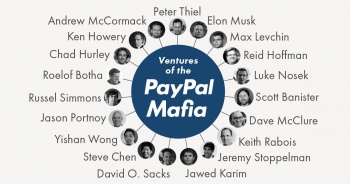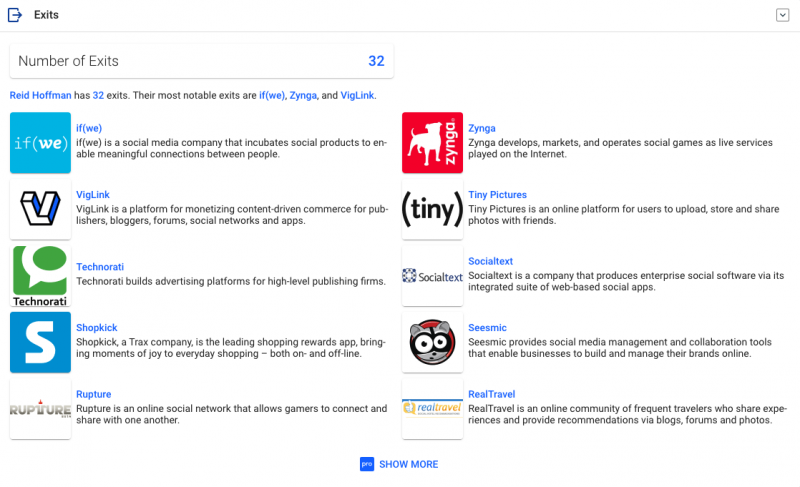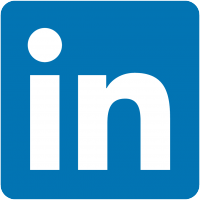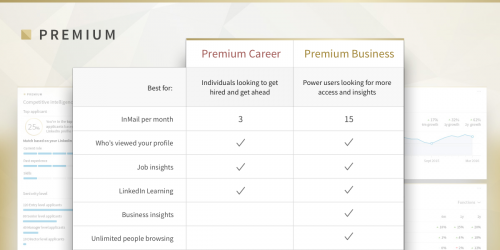Reid Hoffman
| Birthname | Reid Garrett Hoffmann |
| Date of Birth | August 5, 1967 |
| Birth Place | Palo Alto, California, U.S. |
| Nationality | American |
| Occupation | Entrepreneur |
| Biography | Founding Paypal & LinkedIn and Investing in Facebook & AirBnb |
Life Outside of LinkedIn
PayPal
Just after SocialNet had failed, Hoffman joined an internet startup that focused on sending money electronically from person to person. This was a revolutionary idea, as credit cards were the most novel "electronic currency" at the time. Paypal began to grow, and Hoffman remained alongside Paypal until its eventual sale to eBay for $1.5 billion. The group of people that founded Paypal include some of the most impactful entrepreneurs, investors, and technologists of the 21st century. This list includes Peter Thiel, Elon Musk, Steven Chen, and Chad Hurley. These individuals were deemed the "Paypal Mafia", as they all went on to develop major followings and influence in their respective fields of work. [4] One of the uniting characteristics about these men was their desire to change the world. Making connections, converting to electric vehicles, individualizing video-streaming, all of these men have played an integral role in the formation of the technologically integrated environment in which society lives.
Hoffman was approached with the opportunity to invest in a company that paralleled his vision for growing the world through mutual connectivity via an internet platform. In 2005, he had the opportunity to invest in a budding social media platform that was supposedly quite popular on college campuses across the United States. Having a reasonable fortune from the sale of PayPal years earlier, he made an investment in the company. Additionally, he connected the company with his good friend and PayPal colleague Peter Thiel. Peter Thiel ended up being one of the largest contributors to this company's seed round of funding. Years later, the company grew and grew, netting Hoffman and Thiel many millions of dollars. This company turned out to be Facebook. [5]
Other Investments
Overview of the site
LinkedIn was created with the intent of being a place in which professionally-oriented individuals could connect with others who shared interests, motivations, or connections in the professional world. A profile features a photo of the individual, a brief bio, and various information about one's education history, work history, and skillsets. As of 2020, the site's home interface is a feed of information much like that of Facebook, Twitter, or Instagram. Within this feed are articles about business, updates about connections' career status, trending topics in particular industries, and much more. The user interface is intuitively much like other social media platforms, but LinkedIn is all professionally-based, so profile photos, biographies, and status updates are generally formal, grammatically correct, and professionally relevant. One such difference between LinkedIn and Facebook is the addition of messages attached to connection invitations. Instead of a "friend request" as seen on Facebook, LinkedIn has a feature in which an individual wishing to connect with another may send a supplementary message outlining his or her motivation for connection. This is something that is largely unique to the LinkedIn platform and has become a profit-driving feature for LinkedIn Premium.
Hoffman's Impact
LinkedIn is perhaps Hoffman's greatest legacy, as he is the co-founder of the company. Hoffman had always wanted to create a company based around connecting individuals. In 1997, he was compelled to create a website called SocialNet. This was an internet-based platform on which people could meet for anything from tennis partners to dates. Many say that his ideas were just a few years too early, as the emergence of Facebook, online dating sites, and other connectivity platforms largely started to emerge in the mid-2000s. Hoffman had an entrepreneurial inclination since day one. That, coupled with his desire to connect the world via the internet made his founding of LinkedIn inevitable. As seen above, Hoffman has been involved with many different internet-based social media platforms.
How LinkedIn changed the Professional World
ISince its founding, LinkedIn has become the prominent platform for professionals to connect and provide a marketplace for job-seekers and recruiters. 27% of US adults have a LinkedIn page. Similarly, over 30 million companies have a LinkedIn page. LinkedIn features one of the most active job boards. 100 million job applications are submitted through LinkedIn each month. Submitting job applications through a social media page is easy, as an applicant's profile can accentuate one's application. Additionally, LinkedIn provides a platform for individuals to share content. LinkedIn built the infrastructure that allows individuals to like, comment, and post about connections' and influencers' posts. [8]
Ethical Impacts of LinkedIn
Premium Model
As a job-seeker, one can pay $29.99 per month to get access to features that are not included in the free subscription. Such features include a guide that helps with the job search, the ability to see who has viewed your profile, skill courses (offered by LinkedIn), and the ability to InMal other individuals.
As a recruiter, one could purchase LinkedIn Business for $59.99 per month. This subscription allows recruiters to send unlimited messages to potential candidates, see competitors' recruiting information, and view unlimited profiles of job candidates that might be able to fill an open position.
To compare LinkedIn to other social media platforms, LinkedIn is one of the only major social media companies that offers the ability to purchase a subscription for more features. None of Facebook, Instagram, or Twitter offers a premium subscription. LinkedIn has a unique business model in that it collects funds from three different demographics: advertisers, job-seekers, and recruiters. Like most social media platforms, much revenue is created by charging advertisers to place advertisements on their sites. However, unlike these social media sites, LinkedIn collects revenue from job-seekers and recruiters.
Controlling the Recruitment Process
LinkedIn has changed how students and others trying to change jobs interact with the job market. Instead of going directly to job fairs or looking at job posting boards online, many of the jobs that are openly recruiting in the 21st century are posted on Linkedin (not mutually exclusive to other job board sites). Because of this major shift to a centralized job posting and networking board, there has developed a correlated shift in the ways in which people must present themselves. Job hunting has moved online - both for the recruiter and for the recruited. For recruiters, there are many ways to get in touch with potential applicants. One such way is through the use of a mass Inmail message to everyone in a recruiter's desired field. Does the recruiter want an applicant that has their BBA, MBA, or JD? Easy, just check a box. Does the recruiter want someone who studied mechanical engineering and then went on to work as an engineer at a specific airline? Easy, check a different box. What if a recruiter for company A wants to recruit someone that works for company B that is A's biggest competitor? Another box. The process by which LinkedIn allows recruiters to browse through candidates is one that was made by a group of decision-makers. Is eliminating people from a search based on particular criteria a feature of efficiency that was intentionally implemented by LinkedIn? This is possible, but, seeing as LinkedIn has a great deal of power over the recruitment process, they can control particular details that may or may not be ethical. [10]
Data in the Information Revolution
As information becomes more and more relevant in business as well in society's personal lives, often the type of information and the availability of said information is dictated by the host of the platform. In this case, LinkedIn has complete jurisdiction over the personal information that is associated with one's account. This is not unique to LinkedIn as a social media platform. Furthermore, LinkedIn has information that could be valuable to other businesses. Specifically, in LinkedIn Premium's feature of seeing other company's recruitment progress, LinkedIn is leveraging information that others consent to sharing in order to make revenue. The ethics of selling information is up to an individual's respective interpretation. Furthermore, users (individuals) and companies (recruiters representing a company) have limited access to LinkedIn without consenting to have their information collected by LinkedIn. Again, the ethics of this consideration lies in the domain of each respective individual.
Privacy
LikedIn searches have bcome one of the first Google search results when querying someone's name. This brings with it concerns over the information that LinkedIn has over individual's and company's information. Some people may not wish to have their information be available to recruiters wishing to browse an individual's qualifications, endorsements, etc. The question of what information is ethically justifiable to collect is one with which the 21st century has been battling for years.
Profile Features as Commodities
For some, it may seem natural that one's education is tied to one's professional life. As those who have experienced the rise of the internet are aware, college is known to be an indicator of one's knowledge and skills. Additionally, by affiliating with one's educational institution, one is able to connect with other alums or current students who might share similar ideas, experiences, etc and be in relatively closes proximity. However, while the connection between education and professional life seems natural to us, there is a major reliance on the idea that education implies skills. In a world in which higher education is becoming more and more expensive and online educational programs are beginning to standardize with a university education, the need for a "formal" or "traditional" education is becoming less important. Nonetheless, LinkedIn highlights the connections that people possess with their respective educational institutions and, instead of showcasing one's skills and projects, highlights the educational institution that one attended. For some, this may be a boost, but for others whose learning might be supplemented by non-traditional means, this could be a detriment.
Bringing Work Home with You
LinkedIn is compatible with any device that has access to an internet connection. There is a web platform in addition to iOS and Android platforms. This allows users to stay connected when they are anywhere with an internet connection. For those who enjoy LinkedIn for the content that it offers - professionally-curated articles, interesting stories from CEOs, and the like. Though, if someone is inundated with notifications about work content while at home, it could detract from the time in which one wishes to not think about or engage with work-related matters. Each individual's priorities is what determines whether full connectivity to LinkedIn is beneficial, but studies suggest that escaping from work proves to be an effective way of managing stress. [11]
References
- ↑ https://en.wikipedia.org/wiki/Reid_Hoffman
- ↑ https://www.google.com/url?sa=i&url=https%3A%2F%2Fwww.LinkedIn.com%2Fin%2Freidhoffman&psig=AOvVaw3cQZE7sCYDdQirFpJqZ8up&ust=1585586978162000&source=images&cd=vfe&ved=0CAIQjRxqFwoTCNDvsf6RwOgCFQAAAAAdAAAAABAD
- ↑ https://www.google.com/url?sa=i&url=https%3A%2F%2Fmedium.com%2Fswlh%2Fthe-paypal-mafia-is-the-perfect-example-why-the-best-teams-dont-stay-together-long-c8c1dfd5b1f6&psig=AOvVaw0arXez_y-jKnzSLu92RQCz&ust=1585586944528000&source=images&cd=vfe&ved=0CAIQjRxqFwoTCPDeieeRwOgCFQAAAAAdAAAAABAD
- ↑ Charlie Parrish, "Meet The PayPal Mafia, The Richest Group Of Men In Silicon Valley", Business Insider, Sep 20, 2014
- ↑ Owen Thomas, "LinkedIn's Reid Hoffman Made $111 Million On A $37,500 Investment In Facebook", Business Insider, Sep 10, 2012
- ↑ https://www.crunchbase.com/person/reid-hoffman
- ↑ https://linkedin.com
- ↑ https://www.businessofapps.com/data/linkedin-statistics/
- ↑ https://content.linkedin.com/content/dam/blog/en-us/corporate/blog/2017/Premium-Feature-Set-Final2.png
- ↑ https://monetizepros.com/monetization-basics/how-does-linkedin-make-money/
- ↑ https://hbswk.hbs.edu/item/breaking-the-smartphone-addiction





